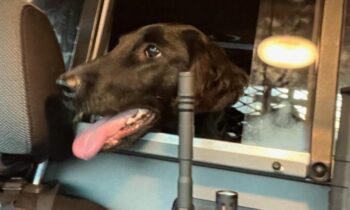

▪ What’s one of the worst things your dog can do to another dog, without physically harming that dog on the spot?
▪ What’s one of the worst things a dog owner can do to another dog owner, without physically harming that other owner on the spot?
▪ What interaction between dogs can do the most permanent damage, without a fight or injuries? What can dog owners do to prevent that damage?
One of the worst things your dog can do to another dog is to approach that other dog when the other dog is not open to the approach.
Most dogs are not comfortable with dogs they don’t know approaching them. Many dogs feel threatened when dogs they don’t know approach them. Some dogs will react to the threat by trying to get away (flight) and some dogs will react to the threat with aggression (fight). Both fight and flight are instinctive reactions to fear.
You don’t want to provoke a fearful reaction from a dog you don’t know? Of course you don’t. You don’t want to provoke a fearful reaction from people you don’t know either, which is why you don’t run up to total strangers walking alone in a park and start patting them on the back or shaking their hands. Sure, you’re friendly . . . but what about them? Maybe they’re frightened when a total stranger accosts them physically. Maybe they have good reason to be afraid?
Are all dogs fearful of dogs they don’t know?
They are not.
Are all people fearful of humans they don’t know?
Of course not.
You can’t know if a dog or a human will be fearful of being approached by a stranger (dog or human) when you’re the stranger. You can guess, but you can’t know.
Oh, sure, you can assume all dogs are friendly and that all dogs welcome approaches by dogs and humans they don’t know. You could assume the same about all human beings, too, but I bet you already realize—that would be crazy.
▪ Not all dogs welcome the approach of dogs they don’t know.
▪ Some dogs definitely don’t welcome the approach of dogs they don’t know.
▪ Some dogs will be fearful of the approach of dogs they don’t know.
You don’t want to cause a dog to be fearful, but you can’t know if a dog will be fearful of being approached by a stranger when you’re a stranger.
How do you avoid causing fear in unknown dogs?
Do not allow your dog to approach unknown dogs.

Photo by April Stevenson
One of the worst things you can do to another dog owner is to let your dog approach their unknown dog.
Instead, make it your default assumption that no unknown dog wants to meet dogs it does not know.
That leads to a new default behavior, starting today . . . no contact with unknown dogs. Period. It’s the only default behavior that you can guarantee will be safe.
Your dog still needs opportunities to interact safely with known dogs under controlled conditions, of course. You need to learn how to make dog-to-dog introductions well, so that the dogs involved don’t feel threatened. You can encourage doggy friendships that develop at their own speed.
For guidance, start in puppy classes or enroll your grown dog in training for family pets, where socialization and play are part of a positive curriculum.
What about dogs that are working?
We all know enough, I hope, not to approach dogs that are working in law enforcement. I don’t see parents encouraging their kids to go pet the police dog when it’s pursuing a criminal. Most adults seem to know enough not to fuss over the cute little beagles at the airport sniffing for contraband, and (probably) most parents will discourage their children from interfering with those dogs. I’ve never seen a parent allow a child to run up to hug a guide dog accompanying a blind person, have you?
Why do grown people think it’s okay to approach service dogs?
Would you grab the crutches from a person on one leg?
Would you shove a person in a wheelchair down stairs?
Why would you ever interfere with a working service dog?!
But you know what’s even worse than a person’s interfering with a working service dog?
What’s truly unconscionable is a dog owner’s allowing his dog to approach a working service dog.
And what’s criminal—in some cases literally—is a dog owner’s allowing his dog to interfere with a working service dog.
To allow behavior that affects the immediate safety of either the service dog or the handler is horrible enough, but in many cases, a bad experience with another dog can have lasting effects—ending the dog’s working life and leaving the handler without a service dog.
Which dog owners most often perpetrate such offenses against common sense and ethical behavior? Dog owners with “fake” service dogs.
Now, remember, it’s not the dogs who choose to be fakes. It’s the owners who claim to be disabled so they can take their pet dogs with them where pet dogs are not allowed. They’re the fakes. Their dogs are innocent victims and can’t be blamed for their behavior when they’ve received no preparation whatsoever for their forays into public life. By and large, those poor dogs are just scared and acting out because of it.
But those dogs, allowed by their irresponsible owners, can walk right up to a working service dog in a public place and end that service dog’s career.
Considering the effort and expense and time it takes to train a dog to perform flawlessly at the high level of deportment and responsibility required of a service dog, ending that dog’s working life prematurely has got to be considered a serious crime.
To commit such a horrendous breach of ethical behavior simply because one wishes to take a pet into public places must be one of the more flagrant displays of human selfishness, I’d say.
How can you, as a responsible dog owner, help to keep working service dogs safe on the job?
▪ Don’t pretend your dog is a working service dog if it’s not. If you’re not disabled, it’s not a service dog.
▪ Should you encounter a working service dog in a place all dogs are allowed, don’t allow your own dog to interfere with that service dog in any way. (“Interfering with” includes barking at, please note.)
What if you’re not with your own dog when you encounter a dog behaving badly in a public place? Are you concerned about the dog’s behavior? Do you feel that you or other people around you might be unsafe?
I suggest doing exactly what you’d do if you saw a human there who made you or other people feel unsafe—report it immediately. Do not approach the dog yourself.
What happens next depends on where you are. Businesses should have staff trained to know exactly what to do to deal with misbehaving dogs on the premises.
▪ When the handler cannot control the dog so that it is not misbehaving, the business can legally ask that the dog be removed from the premises, whether it’s a working service dog or not.
▪ The business can legally ask anyone with a dog on the premises the two questions allowed by the Americans with Disabilities Act (ADA). If the answers do not meet ADA guidelines, the business can ask that the dog be removed.
▪ If you as a patron of the business have any questions about dogs on the premises, talk to the manager.
▪ Likewise, if you appreciate how they’re handling “fake service dog” situations—or if you’re unhappy with their choices—let the business know.
Don’t be “that” dog owner.
▪ Don’t think that two dogs who’ve never met are bound to get along because, you know, they’re both dogs! Not all dogs get along with all other dogs, and we can’t expect that they should.
▪ Don’t take a chance on allowing your dog to approach dogs you don’t know. Set up more controlled social situations where the dogs can feel safe while they decide about being friends.
▪ Don’t allow your dog or your children or yourself to approach a working service dog . . . ever.
▪ Don’t pretend your untrained and temperamentally unsuited pet is a working service dog, and don’t imperil a service dog’s working life by allowing that dog to approach or interfere with it.
▪ For the safety of all, encourage the businesses you patronize to enforce “service-dog only” policies.



